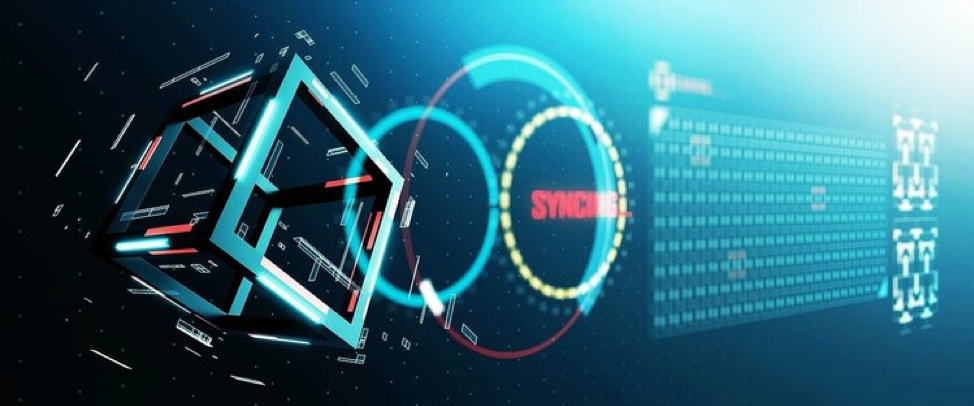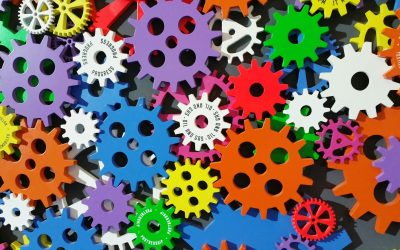Editor’s Note: The DBizInstitute is excited to share this article, written by Dr. Setrag Khoshafian, with our community and in advance of his new book release. Keep an eye on our website as we share additional articles in the coming months written by Setrag, as well as a pending Meet the Author webcast to discuss his new book ‘How to Alleviate Digital Transformation Debt’ expected to air Fall 2021. This article was originally published on CognitiveWorld.com on January 9, 2021.
At the time of this article’s writing, the price of Bitcoin (BTC) skyrocketed above $40,000. That is the highest it has been so far. Will it keep on going up, or is this just hype, or a bubble? Who knows! One thing is for sure, there have been many predictions of the demise of Bitcoin being worthless and going down to zero and so far, all of them have been false. Blockchain is the underlying technology of Bitcoin.

This article is the ninth installment in a ten-part series on Digital Transformation Debt post-Covid-19. Part 1 focused on Culture, while Part 2 delved deeper into Operational Excellence and inter-enterprise Value Streams As A Service (VSaaS). Part 3 explained the spectrum of Automation and the shifts post-Covid-19, and Part 4 demonstrated how a new harvest of Low Code/No Code platforms is empowering Citizen Developers. Part 5 highlighted the emerging trend of tools and best practices for Citizen Data Scientist. Part 6 focused on pragmatic innovation – primarily through the increasingly popular Design Thinking Methodology leveraging digital technologies for innovation, and Part 7 focused on the Customer Experience Optimization. Part 8 expanded on the emergence of the Connected World through IoT.
Part 9 of this ten-part series will expand upon the post-Covid-19 Decentralized World’s emergence and will shed light onto how decentralization is achieved through Blockchains and Blockchain solutions.
All the Bitcoin transactions are recorded in the distributed, replicated, and decentralized Blockchain of Bitcoin. There is not one single “Blockchain.” There are many Blockchains and in different categories. Ethereum, for instance, has its Blockchain. Variants of Bitcoin, which have “forked” for various reasons, have their Blockchain.
Blockchain is the enabler of the Decentralization trend. Perhaps the best way to appreciate Blockchain decentralization (i.e., “decentralization” enabled through Blockchain), is DeFi which stands for Decentralized Finance. Like centralized finance or banking, up to relatively recently, cryptocurrency exchanges were centralized. Decentralized exchanges, such as Uniswap, have arrived – especially since Q3 2020. Decentralized exchanges use Automated Market Maker (AMM) software. Here is the core advantage: “Instead of Wall Street market makers or centralized cryptocurrency exchanges collecting the lion’s share of trading fees, AMMs provided returns and voting rights to anyone willing to add liquidity to a contract — whether audited or not. When before has a borrower earned a return on a debt from their lender?”
As we shall see, Decentralization has many applications besides DeFi. It is one of the most critical Digital Transformation trends, especially post-Covid-19.
Blockchain Architecture
A Connected and Decentralized world involves humans, robots, connected devices – all leveraging Blockchains – especially for inter-enterprise transactions and policies. In addition to the peer-to-peer decentralized and disintermediated recording of transactions, Blockchains also execute Smart Contracts. Smart contracts are the rules and mutual agreements between parties that get implemented in the Blockchain.
In terms of the implementation, maintenance, accessibility, and consensus validation of Blockchains, there are two main categories:
- Permission-less or Public Blockchains allow anyone to join as a Blockchain node and become a consensus validator. Popular cryptocurrencies such as Bitcoin and Ethereum are public Blockchains.
- Permissioned or Private Blockchains require permissions for joining the Blockchain ecosystems. Typically, there are specific consortia or industry groups that leverage private Blockchains for their community. Hyperledger Fabric is one of the more popular frameworks for developing permissioned or private Blockchain solutions.
The following illustrates a robust four-layer reference architecture for innovative Permissioned or Permission-less Blockchain solutions with Smart Contracts:
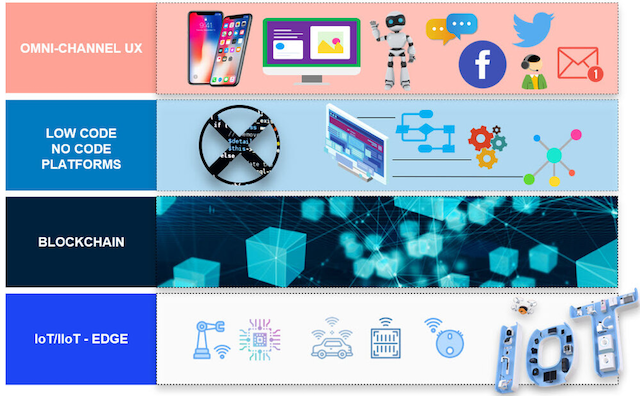
- Omni-Channel User Experience Layer: Interaction and user experiences with Blockchain start with the omni-channel user experience layer. Omni means “all-encompassing.” It means supporting different channels and all communication modes between a Blockchain service or solution provider and the customer consistently. This means the user can interact via a browser, mobile device, service representative, IVR (interactive voice response), or other channels consistently. This “consistency” means that the user’s experience involving the capabilities of the solution is identical (unless there is a reason to provide a different channel-dependent experience). It also means an interaction can start in one channel and can continue in another seamlessly.
- Low Code/No Code Platforms Layer: As discussed in Part 4, Low Code/No Code platforms change the landscape of programming and application development – primarily through empowering Citizen Developers. The second layer consists of Low Code/No Code platforms for innovating and deploying Blockchain solutions. Now, even though the ecosystem of Low Code/No Code includes many platforms for different objectives, at this junction, there are relatively few platforms that focus explicitly on Blockchain. It is possible to use Low Code/No Code platforms with automated integration to Blockchains. However, there are some examples of Low Code/No Code platforms that specifically target Smart Contracts.
- Blockchain Layer: The middle layer of the three-tier architecture is the Blockchain layer. It could involve one or more Blockchain implementations for specific cryptocurrency objectives. The Blockchains will execute either smart contract rules or exchange cryptocurrencies for payments or both. The Low Code/No Code applications will leverage Blockchain – primarily through Smart Contracts: to realize a service level smart contract obligation – financial, compliance, time-related, etc. – between parties. The more impactful value of Blockchain is achieved through No Code applications that is a high-value mission-critical solution. Both the Low Code/No Code platforms layer and the lower IoT/IIoT layer will be leveraging the Blockchain layer.
- IoT/IIoT Connected Device Layer: As discussed in Part 8, IoT/IIoT devices provide unprecedented connectivity, especially at the edges. The lowest layer will be this IoT/IIoT connectivity layer. Physical and increasingly connected devices are becoming part of robust Low Code/No Code applications. With Blockchain and IoT/IIoT edge computing, an added advantage is pushing the execution and the transactions to the edges. Connected devices can potentially carry out autonomous or semi-autonomous transactions. The overall Valuechain is managed and automated at the top layer, with IoT/IIoT edge computing transactions delegated to the connected devices – that can leverage Blockchain as needed.
Blockchain Intelligence
Tremendous opportunities are leveraging Artificial Intelligence (AI) for automation and optimizations for Low Code/No Code Blockchain applications. We have called this Blockchain Intelligence.
There are four primary sources of knowledge and intelligence for Blockchain:
1. Regulations, Knowledge, Policies, & Procedures: This spans operations manuals, organizational procedures, and regulatory compliance documents. Rules-based systems and language processing can be leveraged to extract the knowledge and then operationalize it in Blockchain applications. Blockchain Smart Contracts can be leveraged to digitize the business rules in the Policies & Procedures (e.g., by-laws or operational regulations) and execute them via Low Code/No Code applications on the Blockchain.
2. Human Intelligence: Cognitive workers – people who use data or information to do their jobs – have a lot of deep knowledge in their heads that need to be harvested. Blockchain Decentralized Applications, implemented through Low Code/No Code platforms, can leverage the Citizen Developer’s knowledge by digitizing business rules or through fully or semi-automated intelligent assistants.
3. Legacy Code Business Logic: The embedded policies can become ossified, with little or no business visibility. They are difficult to change or extend. The challenge is to leverage the intelligence in legacy systems while allowing the organization to modernize and be agile. Blockchain Architectures involve orchestration of Smart Contracts with Low Code/No Code automated API invocations of AI decisions through secure exchanges.
4. Data: Blockchain stores all the business transactions: the addresses of the senders/receivers of exchanges, if applicable, the amounts of exchanges, the meta-data of transactions, and the execution of Code in the Blockchain, etc. The chain in Blockchain only grows and is never deleted. Blocks on the chain cannot be modified. Only validated blocks can be added to the Blockchain. So, each Blockchain grows. Blockchain Data Mining and Machine Learning techniques with Blockchain transaction data sets are a tremendous source of intelligence.
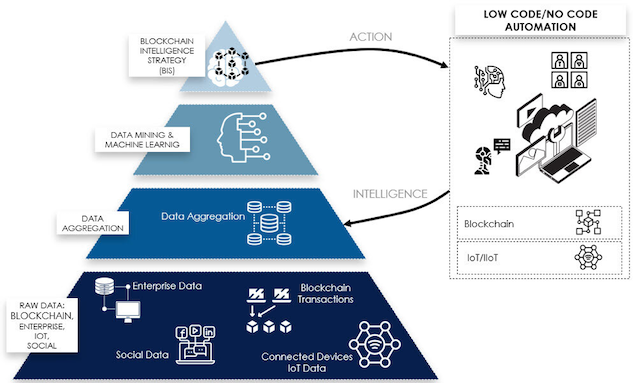
In addition to the on-chain Blockchain data, there are several off-chain data sources: social interactions, legacy data, and IoT/IIoT data. There are patterns of knowledge and intelligence hidden in the aggregate of these raw data sources. The following illustrates the continuous Insight-to-Action BIS. The “action” is realized through Low Code/No Code automation solutions. Decisions based on AI predictions can be fed back to the data source to improve the precision of the predictions continuously.
Blockchain for Inter-Enterprise Master Data Management (MDM)
Conducting business transactions across organizational boundaries has all the challenges of intra-enterprise silos and adds several others. Often there are multiple versions of the “truth.” Inter-Enterprise exchanges and data sharing are marred with various inefficiencies: manual forms and paperwork, error-prone replications, delays due to organizational or bureaucratic inefficiencies, errors in language translations, especially cross-country exchanges, difficulties, and challenges in reconciling governance policies – to name a few. Hence the need for inter-enterprise Master Data Management (MDM). Blockchain is an excellent solution for inter-enterprise MDM. Here are a couple of examples:
- Blockchain for Master KYC: Know Your Customer (KYC) is a process by the government regulators that banks and financial institutions must follow to verify the customers’ identity. If a customer opens an account in, say, one bank and then wants to open another in a different financial organization that also requires KYC, they must go through the process again. Blockchain alleviates this need by allowing even potentially competing financial institutions to share KYC information about their customers. For example, Samsung’s Nexleger Blockchain platform has been used by a consortium of Korean Banks to share customer identity.
- Blockchain for Master Vehicle Identification, Registration, and History. Another huge potential area for inter-enterprise MDM with Blockchain is recording Vehicle Identification, processing the Registration, and the history of a vehicle on the Blockchain. The Blockchain entries can identify assets. The Blockchain can store the entire history of the vehicle’s ownership, significant events such as accidents, reports, or problems, and the driving and maintenance history. One company that is doing this is VINchain. The Blockchain stores the master information and transaction about the vehicle with the given VIN. All interested parties share the master Blockchain: OEM manufacturers, distributors, dealers, owners, mechanics, DMVs, and so on.
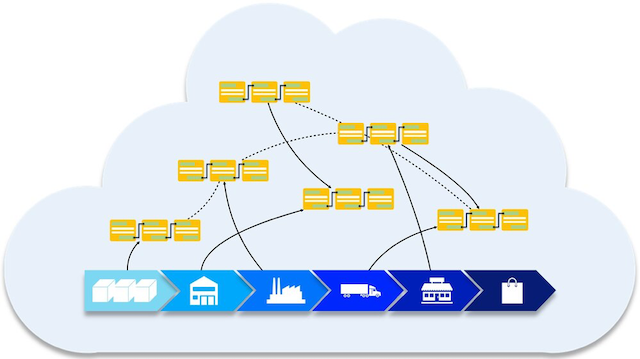
- Supply Chain MDM. Supply Chain is the quintessential Extended Enterprise application domain. Interestingly Supply Chain is also touted as an ideal use-case for Blockchain technologies. Blockchain can be a good backbone for Supply Chain through several essential categories of exchanges or flows: contractual flow, logistics (movement of goods and material) flow, proper documentation flow, and of course, is the foundation of cryptocurrency, the financial transaction flow. The Covid-19 pandemic highlighted the vulnerabilities in supply chains, as warehouses and retail stores ran out of popular items in high demand. Blockchain and Covid-19.
To review, Blockchain is a master information repository that is shared across organizations. Organizations participating in the value chain to achieve a particular purpose – for instance, deliver goods on a supply chain – can modify or add transactions to the Blockchain.
The other essential characteristics of Blockchain is the fact that it is secure and “trustless.” This term is a bit confusing. It means that the parties engaged on the Blockchain have a healthy dose of mistrust towards each other, but they can rely on the algorithms and the Blockchain technology to make sure the shared transactions (the “truth”) on the Blockchain is reliable.
Using Blockchain effectively and focusing on the value chain – after all, Blockchain realizes the “Internet of Value” –might be one of the best technologies directly addressing several key pandemic challenges. The Blockchain Research Institute has identified several compelling use cases of Blockchain in a pandemic. These include Self-sovereign Identity, Data Sharing, Just-in-time supply chain, and Rapid Response Registry for the Workforce. The notion of a “self-sovereign” identity is quite impressive. The report describes it as an “inalienable digital identity, one that is neither bestowed nor revocable by any central administrator and is enforceable in any context, in-person and online, anywhere in the world.” Identity through Blockchain balancing unique identification and enforceability with privacy protection from central authorities is a compelling but challenging case.
We highlight some of the more practical potential applications of Blockchain pandemic use cases:
- Mobile, Additive and Social Manufacturing: As mentioned above, participating in end-to-end production with 3D printing, together with social and additive manufacturing. Blockchain can be used for the exchange of components, payments, and tracking in the supply chain. Blockchain is the foundation of cryptocurrencies. There are many opportunities for trading with Blockchain. One such pragmatic example is the reconciliation and delivery of trades among several companies. Blockchain can provide unprecedented accessibility and transparency of different documents (regulatory, engineering, maintenance, supply, contractual, etc.), between various participants of end-to-end Valuechains.
- Food Supply Chain Traceability: Supply chain is one of the most robust applications of Blockchain – as value and tracking can be traced on immutable ledgers across enterprises in potentially different countries. Traceability for manufacturing parts – in conjunction with IoT and AI – can potentially address challenges of supply chain vulnerabilities, especially during disasters such as pandemics. More importantly, for food supply chains, traceability becomes critical and lifesaving. There are promising proposals and ideas. For instance, Food Safety and Inspection Service (FSIS) commissioned IBM to develop a proof of concept with Blockchain for food supply chain traceability.
- Servicing and Operations: Provisioning the best field service technicians and continuous monitoring for optimizations can leverage Blockchain – for smart contracts, payments, and recording of operational work on the decentralized ledger. Blockchain also promotes alternative flat organizational patterns for servicing and operations. Applications built on Blockchain can allow organizations to execute smart decisions (via smart contracts running on the Blockchain) such as proposals, recommendations, asset allocations, votes, etc. These can involve servicing employees as well as partners and even customers across multiple organizations.
- Contact Tracing and Health Management is a robust use case for Blockchain. The readily available and consistent identity and potentially health records on the Blockchain open to different respondents and health organizations is a very compelling use case for Blockchain. For example, UAE is an early adopter of innovative technologies, and it has adopted Blockchain for government services – including healthcare, especially to fight Covid-19. There have also been exciting advances leveraging Blockchain in conjunction with surveillance technology elsewhere, especially in China. The UAE plans to have 50% of government transactions on the Blockchain by 2021!
- Vaccine Supply Chain with Blockchain. Blockchain has a lot of synergy with IoT – the Internet of Things. The post-Covid-19 World will be both increasingly decentralized as well as optimally connected. However, even though are success stories in applications such as Supply Chain, we still have a long way to go for global adoption of Blockchain. The next phase in the evolution for the Internet: the Internet of Value, where “value” is not just monetary but also in the robustness of decentralized collaboration. For instance, monitoring and improving the Covid-19 Vaccine supply chain operations will be the challenge in 2021. Blockchain technology can help, but as pointed out by the World Economic Forum, “The difficulty does not lie in the technology, but rather in building and enlisting all of the multiple players to take part in the solution. It is in essence more of a political hurdle than a technological one.”
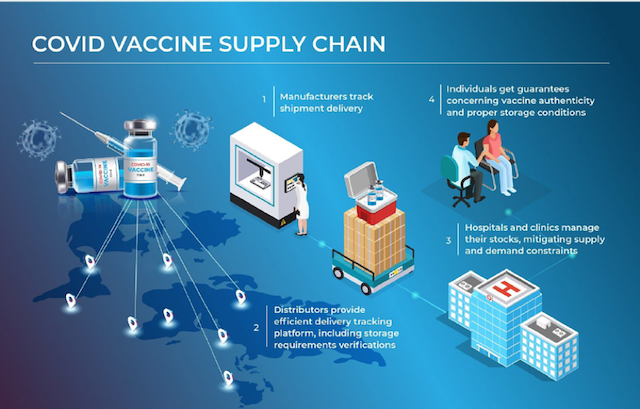
Image: Hexa Foundation
Recommendations
The post-Covid-19 era is a decentralized world! Yes, it is also connected and intelligent – but Decentralization is an essential pillar that is becoming increasingly important in the Covid-19 era.
The prioritization for the Blockchain initiative depends upon the vertical sector of the organization. However, all sectors can benefit from several common strategies. Khosh Consulting can help you on your journey:
- Blockchain and Cryptocurrency Continuous Education: There is still quite a bit of confusion surrounding Cryptocurrencies and Blockchain technologies in general. Khosh Consulting can help you separate “the wheat from the chaff.” As illustrated in this article, many real-life examples could inspire you to embark upon innovative projects, leveraging Blockchain, and perhaps specific tokens or cryptocurrencies for your financial transactions or exchanges. Be careful, though. There are many organizations out there offering Blockchain or Cryptocurrency courses (mostly online) or education.
- Blockchain Project Prioritization: Empowered with a more robust understanding of Blockchain, start incorporating Blockchain solutions and technologies within your prioritized Design Thinking iterations. In most projects, Blockchain – or other technologies such as IoT – will not be the core technology but an enabler only if it makes sense. Occasionally in your Design Thinking iterations and backlogs, you will have projects where Blockchain will be core to the solution. Supply Chain is one category. Here again, Khosh Consulting can facilitate Design Thinking, Design Sprint, and Low Code/No Code MVP implementations with Blockchain components.
- Blockchain Reference Architecture and Technology Solution Mapping: We shared the high-level multi-tier architecture for Blockchain. It would help if you adopted this to your enterprise architecture and select tools, enablers, platforms, and capabilities for each of the layers. Examples here include Low Code/No Code platforms for Blockchain solutions, automated integration options, Blockchain, and IoT technology components. This is a tall order and, again, Khosh Consulting can help you with your Enterprise Architecture best practices for the low hanging fruit prioritized projects and your overall journey.
This is a ten-part article series centered around Digital Transformation Debts in the wake of the Covid-19 pandemic. Be sure to check out all ten articles!














